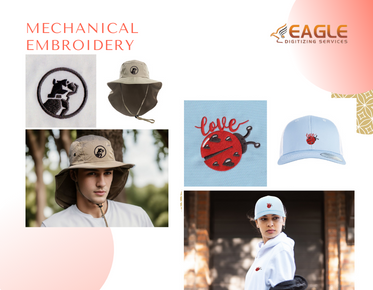How to Use Negative Space Effectively for Stunning Designs/Eagle Digitizing
In the world of design, negative space is more than just the empty area surrounding your subject; it is a powerful tool that can enhance your compositions in remarkable ways. Understanding how to manipulate this often-overlooked aspect can elevate your vector designs, providing clarity, balance, and visual intrigue. Let’s dive into the art and science of utilizing negative space to create stunning, impactful designs. If this post piqued your curiosity and you wish to learn more about Embroidery Digitizing, feel free to reach out to us.
Understanding Negative Space: The Basics
What is Negative Space and Why It Matters in Design
Negative space, often referred to as white space, is the area around and between the subjects of an image. This space can be as crucial as the objects themselves, creating breathing room and allowing the viewer’s eye to navigate the design. By consciously incorporating negative space, designers can enhance focus on the primary elements, streamline compositions, and even communicate messages subtly. Its significance lies in its ability to define shapes, evoke emotions, and create a harmonious visual experience.
The Difference Between Positive and Negative Space
Positive space refers to the main subjects or elements of a design, while negative space is the backdrop that surrounds them. This relationship is symbiotic; one cannot exist meaningfully without the other. The interplay between positive and negative space is fundamental to composition. Think of it as a dance between the forms and the voids—each enhancing the other. Understanding this dynamic enables designers to craft visually arresting and balanced compositions.
The Power of Minimalism: Less is More
How Minimalism Enhances Your Design with Negative Space
Minimalism, at its core, advocates for simplicity and clarity. By embracing minimalistic principles and effectively using negative space, designers can strip away the superfluous and focus on the essence of their message. This approach not only highlights the main elements but also fosters a sense of tranquility and sophistication. The beauty of minimalism lies in its ability to communicate profound ideas with just a few elements, allowing negative space to amplify the overall impact.
Examples of Minimal Designs That Effectively Use Negative Space
Iconic designs like the FedEx logo exemplify the brilliance of negative space. The hidden arrow between the “E” and “x” cleverly conveys speed and precision while maintaining a clean aesthetic. Another standout example is the World Wildlife Fund logo, where the panda’s form is captured using negative space, creating a memorable and impactful image. Such designs demonstrate how minimalism, combined with intentional negative space, can lead to unforgettable branding.
Creating Balance: The Art of Visual Harmony
Achieving Balance Between Positive and Negative Elements
Visual balance is critical in design. Striking the right equilibrium between positive and negative elements ensures that no part of the design overshadows another. This balance creates a sense of harmony, making the design more pleasing to the eye. Consider employing the rule of thirds or the golden ratio as guiding principles to distribute space evenly across your compositions. These techniques encourage a well-rounded aesthetic that captures the viewer’s attention.
Techniques for Distributing Space Evenly in Your Designs
One effective technique for achieving balance is to create a visual hierarchy. By emphasizing certain elements through size, color, or positioning, you can guide the viewer’s eye while maintaining a sense of equilibrium. Utilizing grids can also aid in aligning elements and ensuring that negative space is distributed thoughtfully throughout the design. These methods facilitate a cohesive and harmonious composition, enhancing overall effectiveness.
Negative Space in Logos: Making a Memorable Impression
Iconic Logos That Leverage Negative Space for Impact
Logos are an excellent canvas for exploring negative space. The best embroidery designs cleverly incorporate this technique to create memorable, striking visuals. The NBC logo, with its colorful peacock formed through negative space, is a quintessential example of how effective this approach can be. Similarly, the Spartan Golf Club logo features a hidden golfer silhouette, demonstrating the power of suggestion and visual intrigue. These logos not only stand out but also engage viewers, inviting them to discover hidden meanings.
Tips for Designing Logos with Effective Negative Space
When designing logos, aim for simplicity and clarity. Start by sketching multiple concepts, focusing on how negative space can enhance the overall shape. Experiment with positioning and orientation to see how elements can interact dynamically. Always keep the target audience in mind—what message do you want the logo to convey? By prioritizing both positive and negative space, you can create logos that leave a lasting impression.
Enhancing Readability: Text and Negative Space
How Negative Space Can Improve Text Legibility
Negative space plays a crucial role in typography. Proper spacing between letters, lines, and paragraphs enhances readability and makes text easier to digest. Insufficient negative space can lead to cluttered designs, making it difficult for viewers to absorb information. By leveraging negative space thoughtfully, designers can create clean, legible text that draws readers in.
Techniques for Spacing Letters and Words for Clarity
To improve text clarity, consider increasing the kerning (the space between individual letters) and leading (the space between lines). Experiment with different font sizes and styles to achieve the ideal balance. Whitespace around text blocks also helps isolate important information, making it more prominent. When text is thoughtfully spaced, it invites readers to engage with the content rather than overwhelming them.
Using Negative Space for Composition
Composing Your Design with Intentional Negative Space
Intentionality is key when composing designs with negative space. Rather than viewing it as a mere space, treat it as a design element that contributes to the overall composition. Use negative space to frame your main subject, leading the viewer’s eye toward focal points. This technique not only enhances the design's clarity but also infuses it with a sense of purpose.
The Role of Negative Space in Guiding the Viewer’s Eye
Negative space can act as a visual guide, subtly directing the viewer’s gaze through the design. By strategically placing positive elements within the negative space, you can create a path for the eye to follow. This technique enhances storytelling within the design, encouraging viewers to explore and engage with the visual narrative.
Exploring Shapes: Finding the Hidden Forms
Identifying Shapes Created by Negative Space
One of the most exciting aspects of negative space is its ability to form hidden shapes. When viewing a design, take a moment to look for the shapes created by the absence of elements. This practice can spark creativity, leading to innovative design ideas. By recognizing these hidden forms, you can enhance your compositions and add layers of meaning.
Creative Exercises to Visualize Hidden Forms in Your Designs
Engage in creative exercises that encourage the exploration of negative space. Try sketching random shapes and then identifying negative spaces within them. Alternatively, challenge yourself to create a design where the negative space becomes the focal point. Such exercises foster a deeper understanding of negative space and its potential, ultimately enriching your design toolkit.
Playing with Contrast: Making Elements Pop
How Contrast Enhances the Effectiveness of Negative Space
Contrast is a powerful ally in emphasizing negative space. By juxtaposing light and dark elements, you can draw attention to the interplay between positive and negative spaces. High contrast can make designs more visually striking, ensuring that the viewer’s eye is naturally drawn to the focal points.
Tips for Choosing Colors That Highlight Negative Space
When selecting colors, consider their interaction with surrounding spaces. Bright colors can draw attention, while muted tones can create tranquility. Using contrasting colors effectively can highlight negative space, making it a prominent part of the overall design. Experiment with different color palettes to see how they impact the perception of negative space and enhance your designs.
Incorporating Patterns: The Dynamic Duo
Using Negative Space Within Patterns for Added Depth
Patterns can be a fantastic canvas for utilizing negative space. By incorporating negative space into your patterns, you can add depth and complexity, making the design more engaging. This technique creates a visual rhythm that captivates the viewer’s attention and invites exploration.
Examples of Designs That Blend Patterns with Negative Space
Consider textile designs where negative space forms intricate patterns, such as floral motifs or geometric shapes. These designs often reveal hidden elements when viewed from different angles, creating a delightful surprise for the observer. Additionally, branding materials that incorporate negative space within patterns, such as wallpapers or packaging, showcase how this approach can enhance visual storytelling.
Negative Space in Illustrations: A Unique Perspective
Techniques for Using Negative Space in Vector Illustrations
In vector illustrations, negative space can transform ordinary designs into extraordinary visuals. Techniques such as silhouette creation and layering can effectively utilize negative space to evoke emotion and intrigue. Illustrators can employ contrasting colors to delineate forms while allowing the background to contribute meaningfully to the overall image.
Successful Illustrations Featuring Negative Space
Notable illustrators, such as Malika Favre and Noma Bar, masterfully incorporate negative space into their work. Favre’s bold, minimalistic designs often showcase forms that emerge from the background, creating striking visuals that communicate powerful narratives. Similarly, Noma Bar’s illustrations cleverly use negative space to create dual images, engaging viewers and inviting them to see beyond the surface. These case studies demonstrate the vast potential of negative space in illustration.
Designing for Different Media: Adapting Your Approach
How Negative Space Usage Differs in Print vs. Digital Designs
The application of negative space varies between print and digital designs. In print, negative space can create a tactile experience, influencing how viewers interact with physical materials. Conversely, in digital designs, negative space enhances user experience, guiding navigation and interaction on websites and apps. Understanding these differences allows designers to tailor their approaches for maximum impact.
Adapting Negative Space Techniques for Various Platforms
When designing for specific platforms, consider the unique requirements of each medium. For example, a social media graphic may benefit from bold, attention-grabbing negative space, while a website should prioritize usability and navigation. Adapting techniques accordingly ensures that designs resonate with audiences and fulfill their intended purposes effectively.
Iterative Design Process: Experiment and Revise
The Importance of Sketching and Iterating in Negative Space Design
The iterative design process is crucial for harnessing the power of negative space. Begin with sketches to explore various configurations, experimenting with how positive and negative spaces interact. Revisiting and refining designs based on feedback allows for deeper insights into the effectiveness of negative space, leading to enhanced outcomes.
Learning from Feedback to Refine Your Designs
Seek constructive feedback from peers or mentors throughout your design journey. Their insights can help identify areas where negative space can be improved or emphasized further. Embracing an iterative mindset fosters growth and encourages a continuous learning process, ultimately resulting in more impactful designs. For the excellent professional digitizing services have no qualms about getting in touch with us.
The impact of negative space in design cannot be overstated. It is a vital component that enhances clarity, balance, and visual appeal. By embracing the principles and techniques discussed, designers can unlock the potential of negative space, leading to more compelling compositions. Keep exploring, experimenting, and applying these techniques as you embark on your design journey—who knows what extraordinary discoveries await in the world of negative space!


.png)
